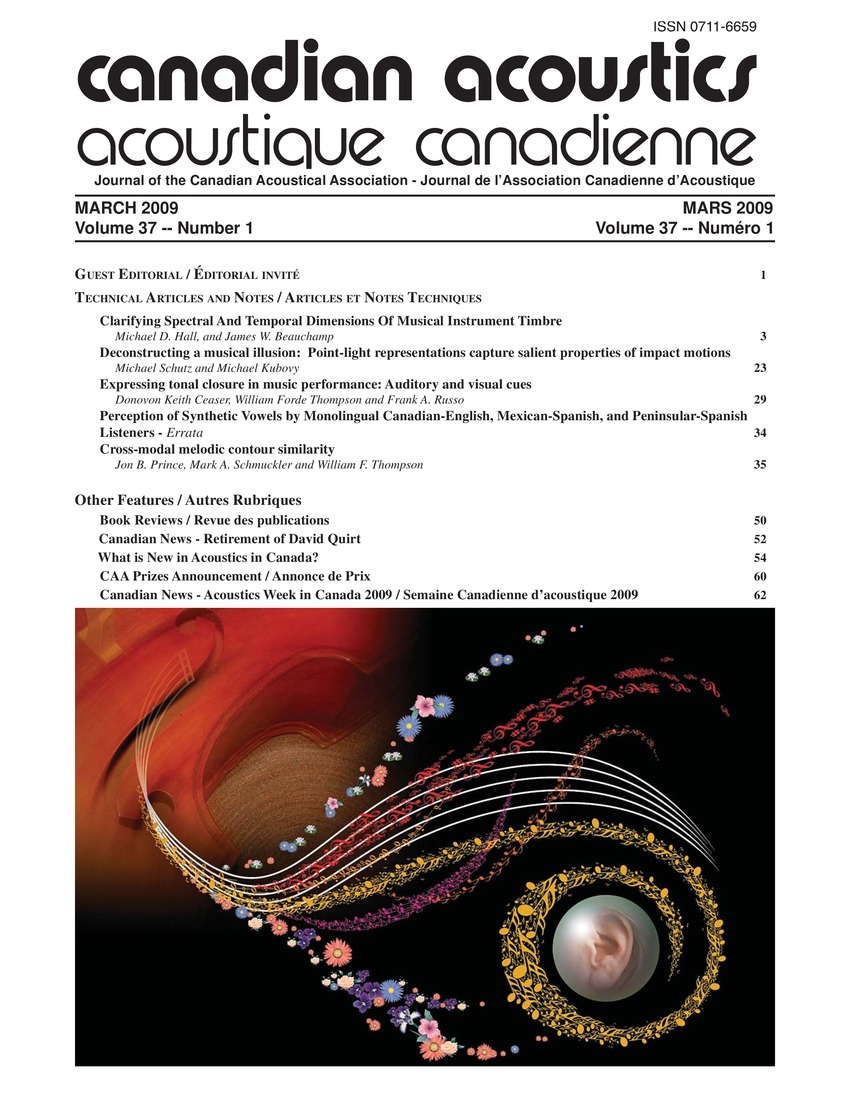Expressing tonal closure in music performance: Auditory and visual cues
Mots-clés :
Acoustic outputs, Facial expressions, Mean values, Music performance, Visual cuesRésumé
Nous avons examiné la communication de conclusion tonale chez les performeurs musicaux, et spécifiquement si elle se fait à travers les manipulations d’expressions faciales et de caractéristiques d’information acoustique autres que la hauteur du son. Deux musiciens ont fredonné une différente version de la mélodie de Sainte Nuit : l’une d’elle terminant sur la tonique de la gamme et donc ayant une conclusion tonale; et l’autre terminant sur la dominante et donc n’ayant pas de conclusion tonale. Lors de l’expérience 1, des extraits d’enregistrements vidéo sans sons des mélodies fredonnées ont été présentés à 15 participants, qui ont ensuite effectué un jugement selon la présence ou l’absence de conclusion tonale dans la mélodie (imaginée). Le niveau d’exactitude des participants excédait le niveau du hasard, indiquant que les musiciens exprimaient la conclusion tonale à travers de leurs expressions faciales et que ces indicateurs furent décodés par leurs auditeurs. L’expérience 2 a été effectuée afin de déterminer si les musiciens communiquaient aussi la conclusion tonale à travers les caractéristiques acoustiques autres que la hauteur du son. La hauteur de tous les sons musicaux dans les mélodies fredonnées a été changée à une hauteur moyenne constante, mais les performances étaient toutefois différentes en tant que force sonore, variations de hauteur microtonale, synchronisation, et timbre. Les participants ont effectué un jugement selon la présence ou l’absence de conclusion tonale dans des extraits d’enregistrement audio des mélodies. Dans l’ensemble, le niveau d’exactitude des participants n’excédait pas le niveau du hasard, mais l’exactitude des jugements envers l’un des deux musiciens excédait à peine le niveau du hasard. Ces résultats suggèrent qu’une conclusion tonale peut être établie à l’aide d’attributs d’expressions de performance autres que la hauteur des sons, mais qu’elle est généralement établie à l’aide d’expressions faciales.Fichiers supplémentaires
Publié-e
Comment citer
Numéro
Rubrique
Licence
Author Licensing Addendum
This Licensing Addendum ("Addendum") is entered into between the undersigned Author(s) and Canadian Acoustics journal published by the Canadian Acoustical Association (hereinafter referred to as the "Publisher"). The Author(s) and the Publisher agree as follows:
-
Retained Rights: The Author(s) retain(s) the following rights:
- The right to reproduce, distribute, and publicly display the Work on the Author's personal website or the website of the Author's institution.
- The right to use the Work in the Author's teaching activities and presentations.
- The right to include the Work in a compilation for the Author's personal use, not for sale.
-
Grant of License: The Author(s) grant(s) to the Publisher a worldwide exclusive license to publish, reproduce, distribute, and display the Work in Canadian Acoustics and any other formats and media deemed appropriate by the Publisher.
-
Attribution: The Publisher agrees to include proper attribution to the Author(s) in all publications and reproductions of the Work.
-
No Conflict: This Addendum is intended to be in harmony with, and not in conflict with, the terms and conditions of the original agreement entered into between the Author(s) and the Publisher.
-
Copyright Clause: Copyright on articles is held by the Author(s). The corresponding Author has the right to grant on behalf of all Authors and does grant on behalf of all Authors, a worldwide exclusive license to the Publisher and its licensees in perpetuity, in all forms, formats, and media (whether known now or created in the future), including but not limited to the rights to publish, reproduce, distribute, display, store, translate, create adaptations, reprints, include within collections, and create summaries, extracts, and/or abstracts of the Contribution.


